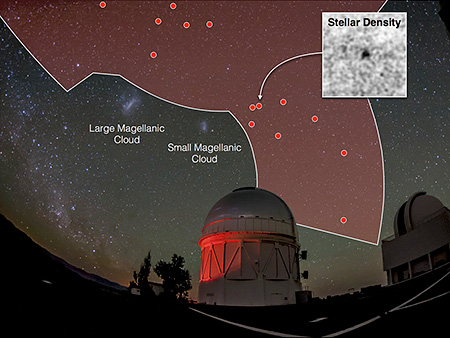17.08.2015
Dark Energy Survey finds more celestial neighbours
Scientists of the Dark Energy Survey, using one of the world’s most powerful digital cameras, have discovered eight more faint celestial objects hovering near our Milky Way galaxy. Signs indicate that they, like the objects found by the same team earlier this year, are likely dwarf satellite galaxies, the smallest and closest known form of galaxies. Scientists of the Excellence Cluster Universe are involved in the Dark Energy Survey.
Satellite galaxies are small celestial objects that orbit larger galaxies, such as our own Milky Way. Dwarf galaxies can be found with fewer than 1,000 stars, in contrast to the Milky Way, an average-size galaxy containing billions of stars. Scientists have predicted that larger galaxies are built from smaller galaxies, which are thought to be especially rich in dark matter, the substance that makes up about 25 percent of the total matter and energy in the universe. Dwarf satellite galaxies, therefore, are considered key to understanding dark matter and the process by which larger galaxies form.
The main goal of the Dark Energy Survey (DES), as its name suggests, is to better understand the nature of dark energy, the mysterious stuff that makes up about 70 percent of the matter and energy in the universe. Scientists believe that dark energy is the key to understanding why the expansion of the universe is speeding up. To carry out its dark energy mission, DES takes snapshots of hundreds of millions of distant galaxies. However, some of the DES images also contain stars in dwarf galaxies much closer to the Milky Way. The same data can therefore be used to probe both dark energy, which scientists think is driving galaxies apart, and dark matter, which is thought to hold galaxies together.
Scientists can only see the faintest dwarf galaxies when they are nearby, and had previously only found a few of them. If these new discoveries are representative of the entire sky, there could be many more galaxies hiding in our cosmic neighbourhood.
This year, more than 20 of these dwarf satellite galaxy candidates have been spotted. Thus, the number of these objects nearly doubled in just one year. Prior to 2015, scientists had located only about two dozens of such galaxies around the Milky Way.
The closest of these newly discovered objects is about 80,000 light-years away, and the furthest roughly 700,000 light-years away. These objects are, on average, around a billion times dimmer than the Milky Way and a million times less massive. The faintest of the new dwarf galaxy candidates has about 500 stars.
Most of the newly discovered objects are in the southern half of the DES survey area, in close proximity to the Large Magellanic Cloud and the Small Magellanic Cloud. These are the two largest satellite galaxies associated with the Milky Way, about 158,000 light-years and 208,000 light-years away, respectively. It is possible that many of these new objects could be satellite galaxies of these larger satellite galaxies, which would be a discovery by itself. Satellites of satellites are predicted by dark matter models.
Since dwarf galaxies are thought to be made mostly of dark matter, with very few stars, they are excellent targets to explore the properties of dark matter. Further analysis will confirm whether these new objects are indeed dwarf satellite galaxies and whether signs of dark matter can be detected from them.
The 17 dwarf satellite galaxy candidates were discovered in the first two years of data collected by the Dark Energy Survey, a five-year effort to photograph a portion of the southern sky in unprecedented detail. Scientists have now had a first look at most of the survey area, but data from the next three years of the survey will likely allow them to find objects that are even fainter, more diffuse or farther away. The third survey season has just begun. The Dark Energy Survey is a collaboration of more than 300 scientists from 25 institutions in six countries. Its primary instrument, the 570-megapixel Dark Energy Camera, is mounted on the 4-meter Blanco telescope at the National Optical Astronomy Observatory's Cerro Tololo Inter-American Observatory in Chile.
Further information:
Dark Energy Survey
Fermilab Press release

- The Dark Energy Survey has discovered a total of 17 dwarf galaxy candidates in the past six months (red dots). Several of them are in close proximity to the two largest dwarf galaxies orbiting the Milky Way, the Large and Small Magellanic Clouds, both of which are visible to the unaided eye.(Illustration: Dark Energy Survey Collaboration)





